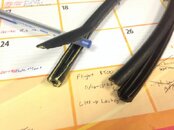Your hose is most likely to "explode" unexpectedly when you first turn your tank on.
I will take an educated guess and say rarely will it explode and sever completely so you're left with a hose whipping you in the face. Most likely there would a loud bang and a gash would form leaking air from the outer bend of your hose, if it happened after you donned your kit.
Keep your hose kinked at a very tight angle near the hose connection when you pressurize and you increase your chances of blowing a hose. So ie. keep your hoses relatively straight or have a long easy curve to it before you turn the tank on. Turn your tank on very slowly until the hoses fully pressurize, then you can spin the knob quicker if you're in a rush.
For HP hoses you might see a bubble form under the rubber after you turn the tank on, then it might blow; sometimes it won't. At that point you should replace it though and not dive it. You can usually tell when an HP hose might blow after you turn on your tank. No bubbling rubber then you're pretty safe.
For LP hoses, if it doesn't blow when you pressurize, you can assume 99.99999% of the time it will not blow unless you inflict trauma on it during your dive.
I will take an educated guess and say rarely will it explode and sever completely so you're left with a hose whipping you in the face. Most likely there would a loud bang and a gash would form leaking air from the outer bend of your hose, if it happened after you donned your kit.
Keep your hose kinked at a very tight angle near the hose connection when you pressurize and you increase your chances of blowing a hose. So ie. keep your hoses relatively straight or have a long easy curve to it before you turn the tank on. Turn your tank on very slowly until the hoses fully pressurize, then you can spin the knob quicker if you're in a rush.
For HP hoses you might see a bubble form under the rubber after you turn the tank on, then it might blow; sometimes it won't. At that point you should replace it though and not dive it. You can usually tell when an HP hose might blow after you turn on your tank. No bubbling rubber then you're pretty safe.
For LP hoses, if it doesn't blow when you pressurize, you can assume 99.99999% of the time it will not blow unless you inflict trauma on it during your dive.






